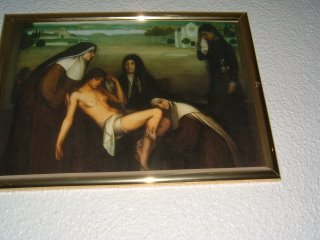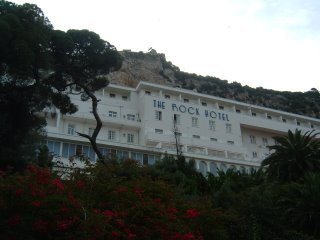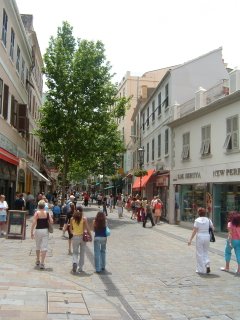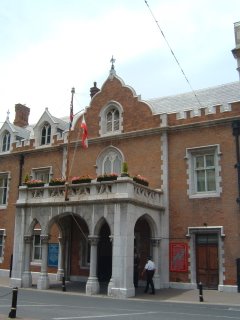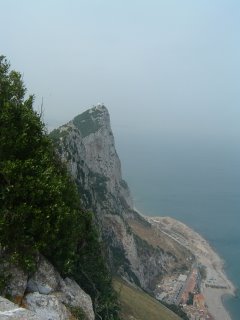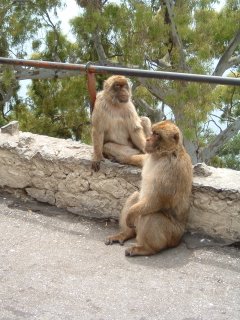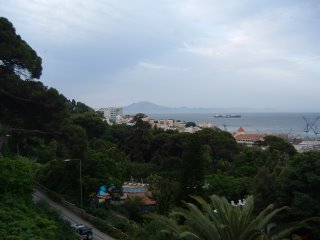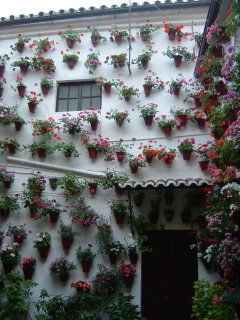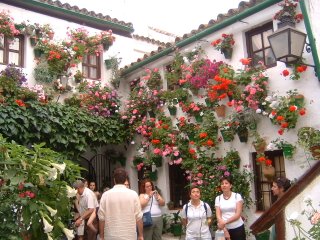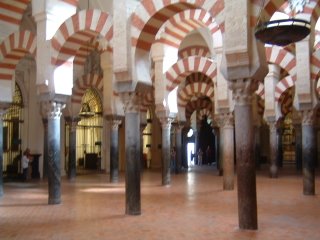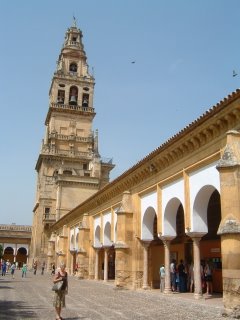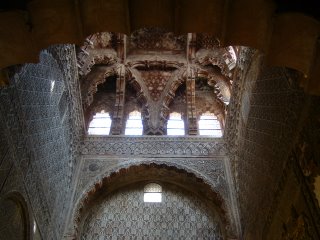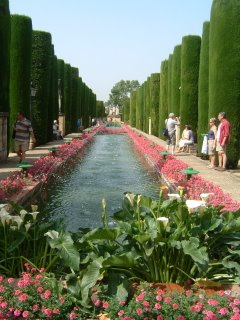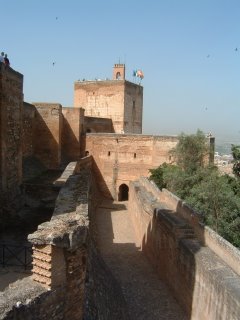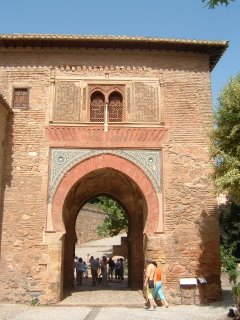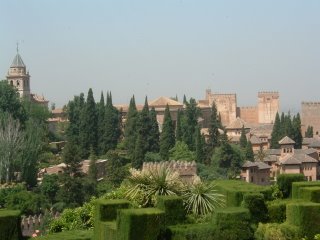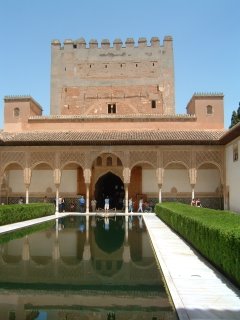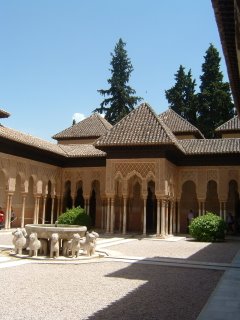Madrid, El Escorial and Toledo, May 10-13
We had made advance reservations for Madrid at a very reasonably priced “Travelodge” (its relationship to the US chain was unclear) outside the city center but on a major urban bus route and near a freeway interchange for trips outside the city. The choice proved sound, although we were limited to dinner in the neighborhood unless we wanted to take a bus downtown when the restaurants opened at 9:00 p.m.—and we certainly didn’t.
Despite the closeness of the freeway interchange, driving in Madrid proved at least as challenging as in Rome and Florence with heavy traffic, erratically parked vehicles, and badly marked streets. We hit upon a winning formula, however, with Georgia driving and Todd navigating. After our excursions we were always able to find free on-street parking near our hotel—a minor miracle in a major European capital.
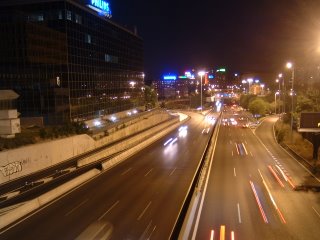
"Our" Madrid freeway interchange
Our first foray outside the city was to El Escorial, the palace/mausoleum/monastery/school built in the 16th Century by King Philip II, inter alia, to inter his father, the Emperor Charles V, himself, and almost all subsequent Spanish monarchs and their wives, plus numerous non-ruling offspring, legitimate and otherwise. Todd had been to El Escorial some thirty years before and knew what to expect, but Georgia was blown away by its scale and grandeur, which reflects the extraordinary wealth that the Spanish crown was receiving from the New World. Photography was generally not permitted inside the building, but the following pictures of Benvenuto Cellini’s “Cruxificion” and the library will give you some idea of the treasures we saw. However, along with the magnificent royal basilica, they contrast with the building’s dour exterior, reflecting Philip’s personality, some say, and the rather cramped apartments (by royal standards, at least) for the king and queen.
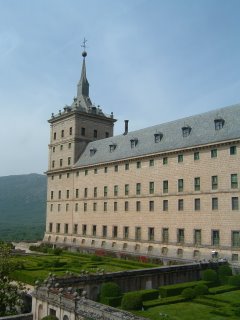
El Escorial
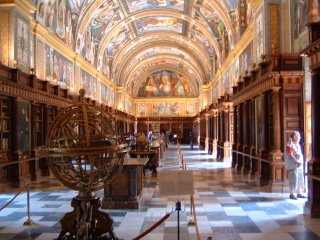
Library at El Escorial
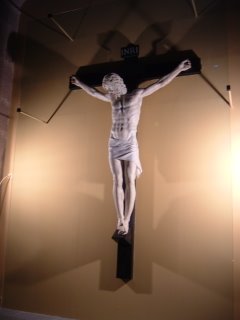
Cellini sculpture at El Escorial
Our second excursion was south to Toledo, a city that prides itself on the fact that it served as Charles V’s capital—to the extent he had one—as double-headed imperial eagles were everywhere in evidence. To our great regret, the Alcazar, which served as the emperor’s palace, was closed for yet another renovation, but we made an extended visit to the cathedral, seat of Spain’s primate. The sacristy holds an extraordinary collection of El Grecos (although we saw his masterpiece, “The Burial of the Count of Orgaz,” in another church), but the interior of the church is equally magnificent, featuring the “Transparente,” a Baroque tunnel of light adorned with painting and sculpture harmoniously joined. A happy surprise was the Convent of San Juan de los Reyes, founded by Ferdinand and Isabella following a victory over the Moors, which was a beautiful 15th Century blend of religion and politics with the Catholic Monarchs’ insignias everywhere to be seen in the mudejar-inspired carvings.
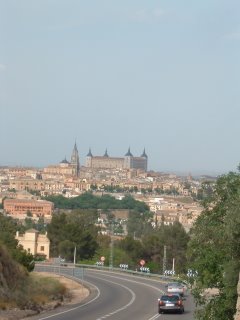
Another "View of Toledo"

Ceiling decorations at San Juan de los Reyes (Toledo)
We spent two days in Madrid itself but barely scratched the surface. One day was devoted to the Prado, where our favorites were the Goyas and Velazquezes, especially the late “black paintings” of the former and the latter’s “Las Meninas,” which was particularly interesting as we had seen Picasso’s “copies” of the painting at the Picasso Museum in Barcelona. (One could devote an entire art course to Velazquez, Picasso and “Las Meninas.”) However, we were also intrigued by the detailed phantasmagorical paintings of Hieronymus Bosch, especially “The Garden of Earthly Delights,” which Phillip II liked so much (just possibly because Bosch’s representations of sin were sexually explicit) that he had it copied into a tapestry at El Escorial.
Our second day we split up with Georgia heading for the Thyssen-Bornemisza Museum, which, she discovered, deserved a great deal more time than she had allowed for her visit. The Thyssen collection, which illustrates the history of Western art from the 14th to the 20th Century, proved to be a magnificent recapitulation of artists, from Titian to Beckmann, whom we had previously seen in our travels as well as much more. Meanwhile, Todd visited the 18th Century Palacio Real, where the Bourbon kings unsuccessfully attempted to outdo their royal cousins in other parts of Western Europe. The palace is kept in immaculate condition, however, as its reception rooms, which dwarf those in the White House, are used for state occasions by Juan Carlos. Both of us visited the Plaza Mayor, the old center of Madrid, and strolled past other sites in this unarguably magnificent city, including the Palace Hotel, where Georgia got her long-awaited haircut and came away delighted with the result.
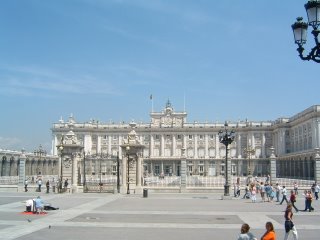
Palacio Real (Madrid)
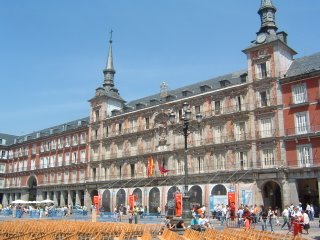
Plaza Mayor (Madrid)
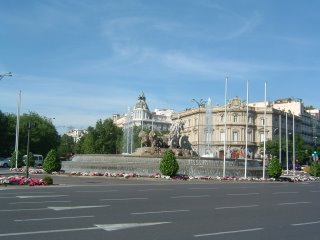
Plaza de Cibeles (Madrid)
Spain is celebrating the 400th anniversary of “Don Quixote,” and to mark the event, Madrid has adorned its streets with quotations from the novel. We particularly liked this one outside the Prado.
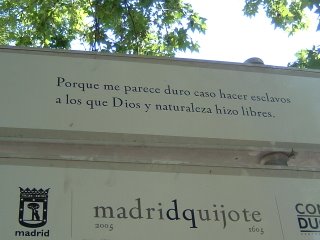
Quixote quote (Paseo del Prado, Madrid)

